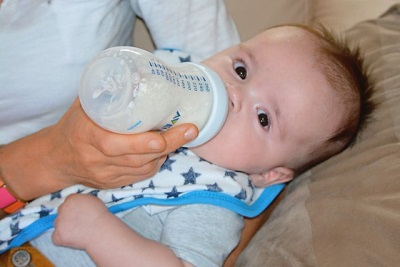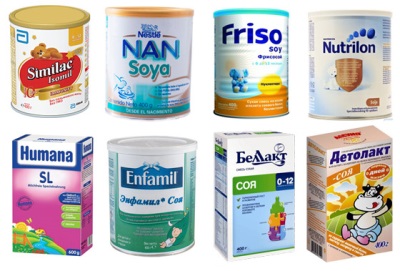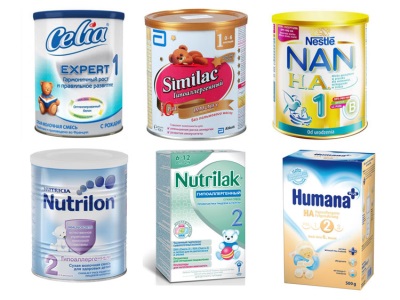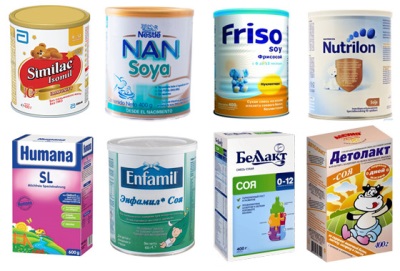Hypoallergenic mixture for children: how to choose the best?
Hypoallergenic mixtures are called specialized food for babies, the purpose of which is to cure or prevent food allergies.
The reasons
In cases where breast milk is insufficient or due to other reasons, the child has to be transferred to the milk mixture.
It happens that when feeding there is the appearance of rash, peeling and redness on the skin, changes in stool (texture, color), difficulty breathing, rhinitis and others, you should definitely go to the doctor.
If the cause of such manifestations is food allergy, the pediatrician will recommend to transfer the baby to one of the hypoallergenic mixtures.
Dr. Komarovsky draws the attention of parents to the fact that the cause of the rash, as a rule, is overfeeding babies. For more on this, see the following passage passage.
On how to find the cause of allergies, see the transfer of Dr. Komarovsky.
Allergy to the mixture in infants diagnosed is not easy, we advise you to read another article.
Allergies to proteins contained in cow's milk are often hereditary. If the close relatives of the baby have such a problem, then the baby may also have the disease.
pros
When prescribing a therapeutic mixture, the manifestations of food allergies quickly pass. The skin of the baby is cleaned, the chair is normalized, the child becomes cheerful and cheerful. This is their main advantage. And the use of nutrition with a preventive effect will help prevent the development of allergy symptoms and go on to the usual mixture without any problems.
Minuses
- Enter them into the diet of the baby is not easy because of their unpleasant taste. The presence of free amino acids in the composition of therapeutic causes their bitter taste. In casein hydrolyzed form, the taste is less pleasant than that of whey hydrolysates.
- Sometimes the reaction can be constipation and regurgitation.
- Also a minus can be called a fairly high price.
In a child who is fed a hypollergenic mixture, feces may acquire a greenish color due to non-digested peptides, as well as amino acids. This is considered a variant of the norm.
Kinds
There are such types of hypoallergenic mixtures:
- Preventive.
- Therapeutic.
Prophylactic
A preventive hypoallergenic mixture is called a milk mixture, the protein molecules of which are partially split into smaller molecules (peptides). They are digested much easier, so their absorption is rarely accompanied by an allergic reaction.
The molecular weight of its peptides affects its ability to cause allergic reactions. If it is more than 5-6 thousand daltons, then it can cause an allergic reaction if there are already antibodies in the baby’s body (allergy was not the first time). That is why with severe manifestations of allergy, they will not help. However, if the remission lasts longer than 6 months, the antibodies, which were formed from long-standing contact with allergens, are gradually destroyed. During this period, the baby can be transferred to a preventive mix.
The following are classified as prophylactic mixtures:
- Nutrilon HA;
- Nan H. A .;
- Similac HA;
- Frisolak HA;
- Humana H. A;
- Nutrilak HA;
- Celia GA and others.
They must indicate that they are low-or hypo-allergenic. Most of them contain more protein than the usual adapted mixture, and fat, by contrast, is less.Most of them lack casein, and whey proteins are partially hydrolyzed.
Carbohydrates can be presented:
- lactose;
- mix lactose and maltodextrin.
The second option is preferable for children who also have lactase deficiency. Mixtures that contain less lactose include Celia, Frisolac and Nutrilak.
Features of prophylactic mixtures:
- Their other name is "partial protein hydrolyzate".
- They are recommended for constant feeding of a healthy baby who is at risk of allergy to cow's milk proteins.
- They are also prescribed to babies who have a long remission. With the help of them carry out the transition from the medical mixture to the usual.
- They are prescribed to children who have first manifested a reaction to cow's milk.
- They are not prescribed for moderate and severe allergies.
- There are formulas 1 for babies 0-6 months, as well as formulas 2.
- Some of these include probiotics (usually bifidobacteria) and prebiotics. These substances have a positive effect in the presence of food allergies. Probiotics are added to Celia GA and Nan GA, and prebiotics are added to Frisolak HA, Nutrilon HA, Similac HA and Nutrilak GA.
- They also add nucleotides, designed to strengthen the immune system of the baby. These substances are found in the mixtures Nutrilak, Frisolak, Nan, Similac and Nutrilon.
- Similac and Nutrilak contain lutein, which contributes to the development of the baby’s vision.
Separately distinguish therapeutic and prophylactic form. These include HiPP Combiotic HA, represented by formula 1 and formula 2.
This mixture for babies up to six months (formula 1) is highly hydrolyzed. Fats in it are the same as in conventional mixtures, and among the carbohydrates in Hipp there is lactose and starch. She is prescribed to newborns with an increased risk of allergies, as well as to children who are mildly allergic.
Formula 2 is a partial hydrolyzate and is recommended for children older than 6 months, as a product that will help the child's body gradually adapt to cow's milk.
The difference between the Hipp kombiotik GA mixture and the rest is that only its composition contains both probiotics, represented by bifidobacteria, and prebiotics, represented by dietary fibers.
For the selection rules, see the next video.
Medicinal
For therapeutic mixtures recommended by pediatricians with food allergies include:
- Nutrilon peptide allergy;
- Friso PEP with nucleotides;
- Nutrilak peptides STTC;
- Alfare;
- Pregestimyl lipil;
- Nutramigen;
- Friso Peps AU.
Features:
- Their other names are “full hydrolyzate” and “highly hydrolyzed mixture”.
- They lack the whole proteins of cow's milk, because they are enzymatically split into peptides.
- Whey mixture peptides are much larger than casein. That is why therapeutic serum-based mixtures are prescribed for moderate food allergies. Note that they are more physiological and are absorbed better than casein ones. Children in this case add a lot faster.
- They have no separation by age, except Nutramigen lipil.
You will learn more about this by watching the following video.
Whey
Serum treatment mixtures are also lactose free (Nutrilak Pepti STZ and Alfare). In the rest of the lactose less than normal. The most pleasant to the taste and the sweetest among whey hydrolysates is Friso PEP.
Among the fats that are included in them are medium chain triglycerides. They are much better digested and are recommended when there are concomitant problems with fat absorption. Nutrilon peptide and Friso PEP include nucleotides as well as prebiotics. Docosahexaenoic acid and arachidonic acid have been added to the medicinal mixtures of Nutrilon and Nutrilak.
Casein
There are no allergic reactions to casein medicinal mixtures due to the low molecular weight of the peptides in their composition, so they are prescribed for severe allergies. However, their difference is lower biological value. And because of the presence of free amino acids, their taste is bitter and unpleasant.
The protein content in them is higher, prebiotics and lactose are absent in them, and carbohydrates in their composition are starch, as well as glucose. Medium chain triglycerides have been added to Pregestimil, Nutramigen and Friso PEP AU. Nucleotides, arachidonic and docosahexaenoic acid were also added to Pregestimil. Also nucleotides are noted in the composition of Friso PEP, and the indicated acids are found in the composition of Nutramigen.
Soy
In addition to whey as well as casein hypoallergenic, crumbs with intolerance to cow's milk offer pleasant soy mixtures. These include:
- Friso-soya;
- Nan soybean;
- Similac Isomil;
- Bellakt Soy;
- Humana SL;
- Nutrilon Soy and others.
They are given to babies older than 5-6 months. It should be introduced carefully, since 30% of newborns are allergic to soy proteins. The required amount is increased during the week, excluding any dairy products from the kid’s menu.
Under the brand names of Nanny and Kabrita, babies who do not tolerate milk from cows are offered mixtures that are based on goat milk. They can be preventive nutrition, as well as be used in cases of pronounced allergic reactions to soy proteins and cows' milk. They are perfectly digested and tasty.
Why do you need to consult a doctor?
Mom may think about transferring the crumbs to a hypoallergenic mixture due to the appearance of a rash in the baby, poor stool or other symptoms that mom will take for an allergic reaction. However, it’s only the doctor who needs to decide if the child needs it.
Perhaps the child simply eats an excess amount of food, and changes in the stool and on the baby's skin appear as a result of its poor digestion. This happens because of its rapid absorption, when it quickly flows from the bottle, and as a result, the baby quickly drinks the right amount, but still feels hungry. And when, after crying, mom gives the crumbs more mixture, this portion will already be redundant.
In addition, medical consultation is extremely important in the case when the baby is really manifested allergy to the usual mixture. Only a pediatrician will be able to determine exactly what caused the allergic reaction, and choose from among their many that which will improve the condition of the baby.
How to choose the best?
If there is food allergy in a child, they are guided by the pediatrician's advice, the baby's age, the composition and the severity of the allergic reaction. Nutrition should be suitable for the child by age, although a large assortment of hypoallergenic mixtures is prescribed for children from birth to 12 months.
Not necessarily focus on the high price, considering it as an indicator of quality. Compare them in composition and choose the best for you, and not a more expensive counterpart. It is important to look at the date of manufacture of the product.
To buy such food for the crumbs for the future also is not recommended, because there is a chance that it will have to be changed. As soon as the symptoms of allergy disappear, the baby is gradually transferred to a prophylactic mixture, and then to a normal one.
In this case, the translation should be gradual! About, how to introduce a new mixtureread our other article.
Opinion of Doctor of Medical Sciences Gribakin S. G., Professor of the Department of Nutrition of Children and Adolescents, you can hear in the next video.



















